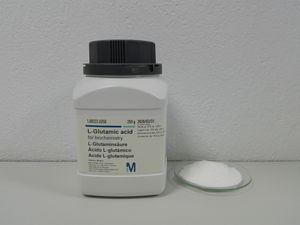Glutamic acid
 L-Glutamic acid in solid form
| |
| Names | |
|---|---|
| IUPAC name
2-Aminopentanedioic acid
| |
| Other names
2-Aminoglutaric acid
| |
| Properties | |
| C5H9O4N | |
| Molar mass | 147.13 g/mol |
| Appearance | White solid |
| Odor | Odorless |
| Density | 1.538 g/cm3 (20 °C) |
| Melting point | 205 °C (401 °F; 478 K) (decomposes) |
| Boiling point | Decomposes |
| 0.75 g/100 ml (20 °C) 0.864 g/100 ml (25 °C) 2.18 g/100 ml (50 °C) 5.532 g/100 ml (75 °C) 14 g/100 ml (75 °C)[1] | |
| Solubility | Soluble in dil. HCl Insoluble in glacial acetic acid, acetone, diethyl ether, ethanol, methanol, toluene |
| Solubility in ethanol | 0.000448 g/100 ml |
| Vapor pressure | ~1.10·10-5 mmHg (20 °C) |
| Acidity (pKa) | 2.10, 4.07, 9.47 |
| Hazards | |
| Safety data sheet | Sigma-Aldrich (D-Glutamic acid) Sigma-Aldrich (L-Glutamic acid) |
| Flash point | Non-flammable |
| Lethal dose or concentration (LD, LC): | |
| LD50 (Median dose)
|
5.110 mg/kg (rat, oral) |
| Except where otherwise noted, data are given for materials in their standard state (at 25 °C [77 °F], 100 kPa). | |
| Infobox references | |
Glutamic acid (symbol Glu) is an α-amino acid, widely encountered as monosodium glutamate (MSG), the key ingredient in the responsible for the savory flavor (umami) of certain foods, and used in glutamate flavorings in food industry.
Contents
Properties
Chemical
Partial neutralization with sodium hydroxide gives monosodium glutamate.
Physical
Glutamic acid is a colorless odorless solid compound, sparingly soluble in water and practically insoluble in organic solvents.
Glutamic acid can exist in two optical isomers, D(-) and L(+). The L form is the one most widely occurring in nature, but the D form occurs in some special contexts, such as the cell walls of the bacteria
Availability
Glutamic acid is sold by chemical suppliers, often as pure enantiomers, L and D. Can also be bought online.
L-Glutamic acid is more available in the form of monosodium glutamate, which is available as food flavoring. The free glutamic acid can be made by adding a strong acid, like hydrochloric acid to MSG.
Preparation and isolation
The addition of an acid, like hydrochloric acid to MSG will give the free acid.
Glutamic acid can be isolated from the product of aerobic fermentation of sugars and ammonia, using the bacterium Corynebacterium glutamicum. Recrystallization of the hydrochloric acid salt of glutamic acid will yield the pure compound. This route, while attractive, is not very economical for the home chemist.
Projects
- Grow bacterial cultures
- Make MSG
Handling
Safety
Glutamic acid has low toxicity. Excess consumption may cause headaches and unspecified neurological problems.
Storage
Glutamic acid should be kept in closed bottles, away from moisture and mold.
Disposal
No special disposal is required, as it's practically non-toxic. Discard it as you wish.
